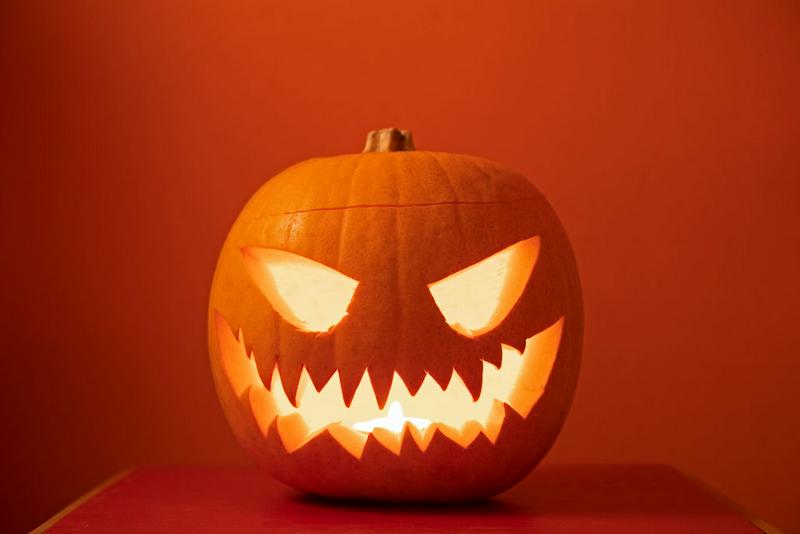The History of Jack-O'-Lanterns: Carving Pumpkins On Halloween Originates In Celtic Tradition
By | October 18, 2019

Today, jack-o'-lanterns are a Halloween staple that almost single-handedly keep America's pumpkin farmers in business. Originally, though, the practice of carving comical or frightening faces into hollowed-out vegetables and lighting them from within had nothing to do with Halloween---even if it was just as spooky. Where did this tradition come from? How was it brought to America? Here’s the story of how jack-o'-lanterns came to be.

Who Was Stingy Jack?
In the 17th-century Europe, "jack-o'-lantern" just meant "a guy with a lantern," often a night watchman, but it was soon used to describe the ghostly lights that often appeared over bogs and marshes. People whispered that the lights had something to do with Stingy Jack, the subject of a folk tale dating back to the 1500s. According to legend, Stingy Jack was such a tightwad that he scammed the Devil himself. One day, Stingy Jack wanted a drink at the nearby tavern, but as his name implies, he was too cheap to pay for it himself, so he invited the Devil to join him. When it turned out the Devil had no cash on him, Jack suggested that the Devil transform himself into a coin that could be used to pay for the drinks. Honestly, the Devil comes off as kind of a rube in this story.

Stingy Jack's Deal with the Devil
After the Devil turned himself into a coin, Jack decided he wasn't thirsty after all. Instead of buying the drinks as promised, he pocketed the coin. Fortunately for Jack, he put the coin in the same pocket as his silver cross. The power of the silver cross prevented the Devil from turning back to ... well, not "normal," but whatever his red, horned deal was. Jack told the Devil he would only free him from his monetary prison if he agreed to leave him alone for one year's time, and if Jack should die during that timeframe, the Devil had to leave his soul alone. The Devil agreed to these terms and conditions.

The Devil Came Back
In exactly one year, the Devil was back to get his revenge on Stingy Jack, but the Devil apparently hadn't shaken his uncharacteristic naïveté. Jack tricked him again, this time convincing the Devil to climb to the top of a tree to retrieve some fruit. After the Devil reached the tallest branch, Stingy Jack carved a cross into the tree, preventing the Devil from climbing down. Again, Stingy Jack offered a deal: He would let the Devil down from the tree if he promised to leave him alone for 10 years this time. The Devil agreed.

Stingy Jack Could Not Go to Heaven or Hell
Sure enough, before the 10 years were up, Stingy Jack died. True to his word, the Devil kept his nose out of it, but that put Jack's soul in a spiritual pickle because God didn't want it, either. His stingy ways had cost him his place in heaven, so the Devil took pity on his frenemy and offered him a burning chunk of coal to help light his way. Stingy Jack placed the glowing ember into a hollowed-out turnip with holes carved into it, and for the rest of eternity, Stingy Jack was doomed to walk the night, carrying his prototype jack-o'-lantern with him. If people caught sight of a strange light in the night, they blamed it on "Jack of the Lantern."

From Turnips to Pumpkins and Beyond
The Irish and Scottish had long carved lanterns from vegetables, usually turnips, beets, or potatoes. They began placing on doorsteps or in windows to scare away evil spirits, specifically Stingy Jack, and children used them to scare their friends into thinking they'd seen Stingy Jack.

Coming to America
When immigrants from Scotland, Ireland, and England came to North America, they brought the tradition of jack-o'-lanterns with them. Furthermore, they discovered in this new world an even more suitable vegetable to carve them from: pumpkins. Over time, the pumpkin became the vegetable of choice from which to carve jack-o'-lanterns because they were larger and easier to hollow out, facilitating more elaborate designs and faces. These immigrants also brought Halloween with them, so the traditions naturally blended, which is how immigration, agriculture, and one supernatural cheapskate gave us the tradition of carving pumpkins on Halloween.

